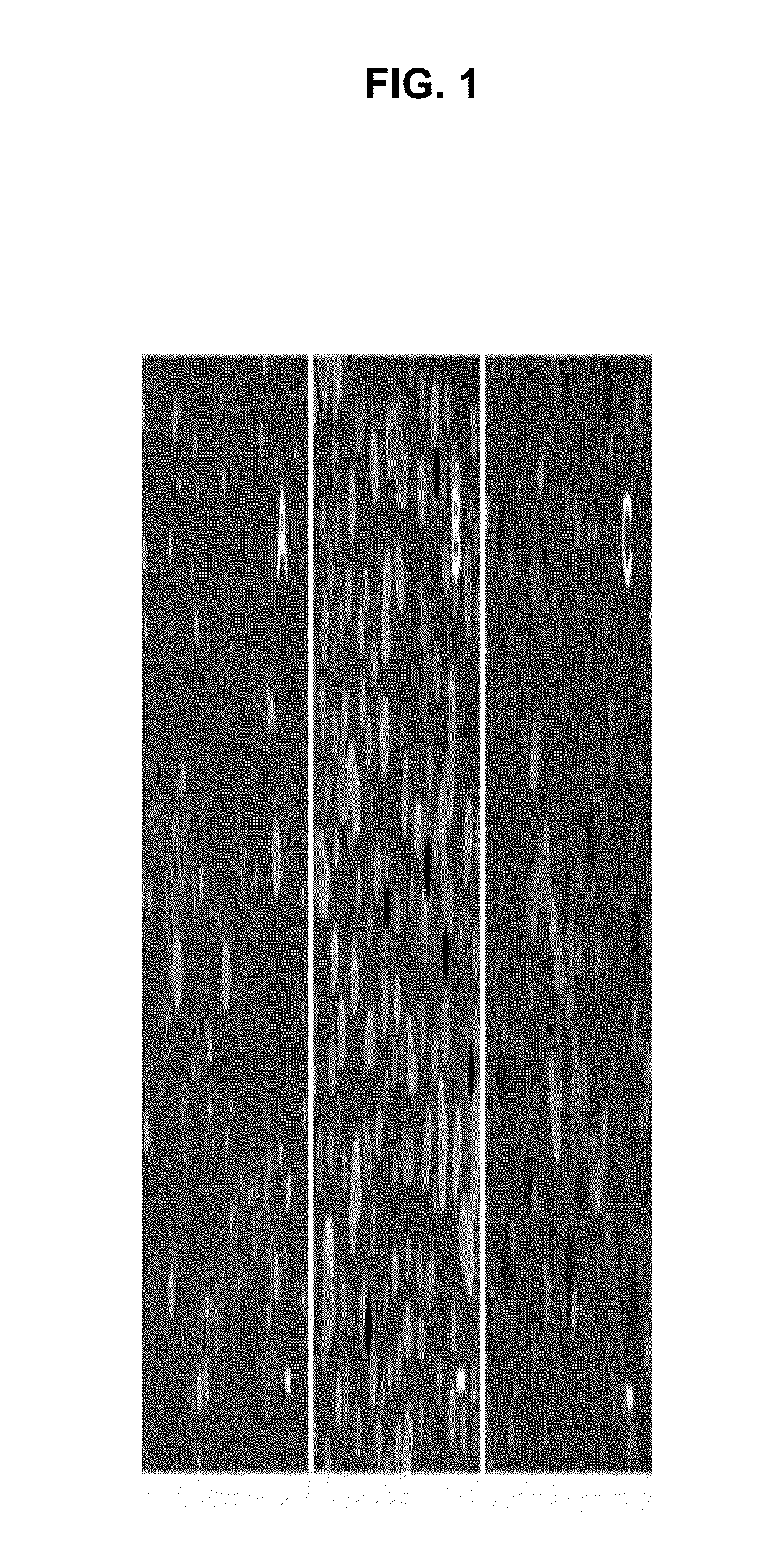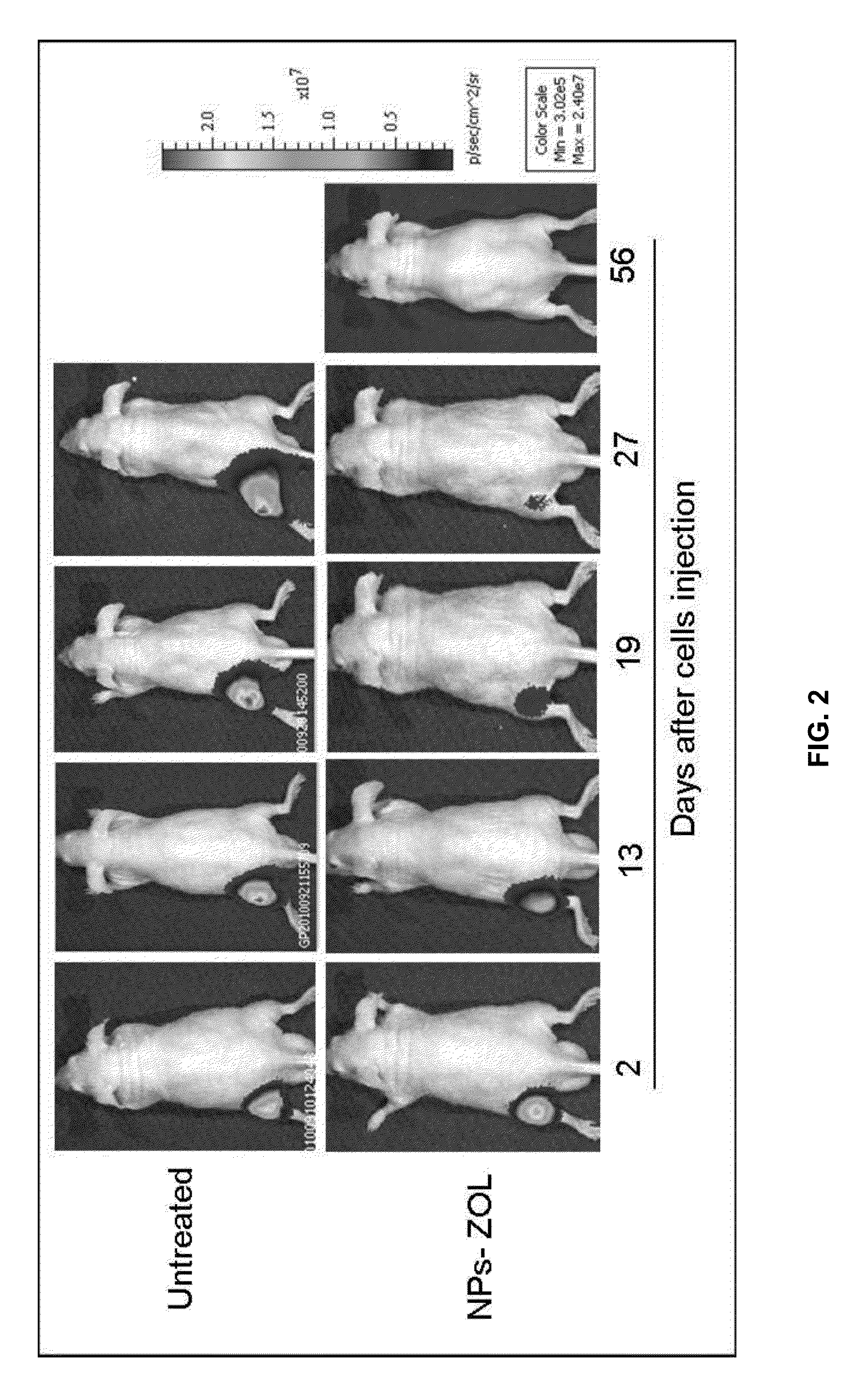Self-Assembling Nanoparticles for the Release of Bisphosphonates in the Treatment of Human Cancers
a technology of bisphosphonates and nanoparticles, which is applied in the direction of antibody medical ingredients, peptide/protein ingredients, extracellular fluid disorders, etc., can solve the problems of inability to demonstrate direct anti-cancer activity in vivo, the ability of zol to act directly against bone metastases has never been demonstrated, and the effect of high drug loading and high reproducibility
- Summary
- Abstract
- Description
- Claims
- Application Information
AI Technical Summary
Benefits of technology
Problems solved by technology
Method used
Image
Examples
example 1
Preparation of Stealth Self Assembly Nanoparticles Containing ZOL
[0041]Ingredients: calcium chloridre 18 mM, hydrogen phosphate dibasic 10.8 mM, 10 or 50 mg of zoledronic acid. 1,2-dioleoyl-3-trimethylammonium-propane chloride (DOTAP) and 1,2-diacyl-sn-glycero-3-phosphoethanolamine-N-[methoxy(polyethylene glycol)-2000] (DSPE-PEG2000) cholesterol (chol).
Step 1: Preparation of Calcium Phosphate Nanoparticles and their Complexes with ZOL
[0042]An aqueous solution of calcium chloride (18 mM) was added, dropwise and under magnetic stirring, to an aqueous solution on dibasic hydrogen phosphate (10.8 mM). The pH of both solutions was adjusted beforehand to 9.5 with NaOH. CaP NPs were obtained by filtration of the suspension through a 0.22 μm filter. CaP NPs were stored at 4° C. before use. CaP / ZOL-NPs complexes (CaPZ NPs) were prepared by mixing a CaP NPs dispersion with an aqueous solution of ZOL at different ZOL concentrations (10 mg / ml of ZOL in water or 50 mg / ml of ZOL in phosphate buff...
example 2
Preparation of Stealth Self Assembly Nanoparticles Containing ZOL
[0045]Ingredients: calcium chloridre 18 mM, hydrogen phosphate dibasic 10.8 mM, 10 or 50 mg of zoledronic acid. 1,2-dioleoyl-3-trimethylammonium-propane chloride (DOTAP) and 1,2-diacyl-sn-glycero-3-phosphoethanolamine-N-[methoxy(polyethylene glycol)-2000] (DSPE-PEG2000) cholesterol (chol).
[0046]Step 1 and Step 2 was similar to that described in Example 1.
Step 3:
[0047]Equal volumes of suspensions containing DOTAP / chol / DSPEG2000 liposomes and CaPZ NPs, respectively, were mixed in a glass tube and the resulting dispersion was allowed to stand at room temperature for 10 min (pre-PLCaPZ NPs).
Nanoparticles Characterization
[0048]The mean diameter of cationic liposomes and PLCaPZ NPs, were determined at 20° C. by photon correlation spectroscopy (PCS). Each sample was diluted in deionizer / filtered water and analyzed with detector at 90° angle. As measure of the particle size distribution, polydispersity index (P.I) was used. Fo...
example 3
Functionalization of Self-Assembling NPs Containing ZOL Bearing Human Transferrin on Their Surface
[0063]Ingredient: 18 mM of calcium chloridre, 10.8 mM of hydrogen phosphate dibasic, 50 mg of zoledronic acid. 1,2-dioleoyl-3-trimethylammonium-propane chloride (DOTAP) and 1,2-diacyl-sn-glycero-3-phosphoethanolamine-N-[methoxy(polyethylene-glycol)-2000] (DSPE-PEG2000) cholesterol (chol), 0.1 mM of human transferrin (Tf).
Step 1: Preparation of PEGylated Cationic Liposomes
[0064]Liposomes consisting of DOTAP / chol / DSPE-PEG 2000 (1:1:0.5 weight ratio) were prepared by hydration of a thin lipid film followed by extrusion. Briefly, the lipid mixture were dissolved in 1 ml of a mixture chloroform / methanol (2:1 v / v), the resulting solution was added to a 50 ml round-bottom flask, and the solvent was removed under reduced pressure by a rotary evaporator under nitrogen atmosphere. Then, the lipid film was hydrated with 1 ml of sterile water and the resulting suspension was gently mixed in the pre...
PUM
| Property | Measurement | Unit |
|---|---|---|
| size | aaaaa | aaaaa |
| pH | aaaaa | aaaaa |
| concentrations | aaaaa | aaaaa |
Abstract
Description
Claims
Application Information
 Login to View More
Login to View More - R&D
- Intellectual Property
- Life Sciences
- Materials
- Tech Scout
- Unparalleled Data Quality
- Higher Quality Content
- 60% Fewer Hallucinations
Browse by: Latest US Patents, China's latest patents, Technical Efficacy Thesaurus, Application Domain, Technology Topic, Popular Technical Reports.
© 2025 PatSnap. All rights reserved.Legal|Privacy policy|Modern Slavery Act Transparency Statement|Sitemap|About US| Contact US: help@patsnap.com


